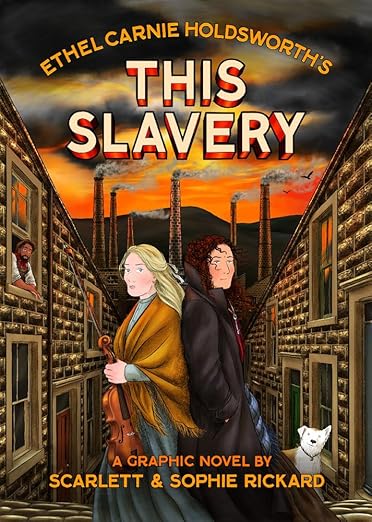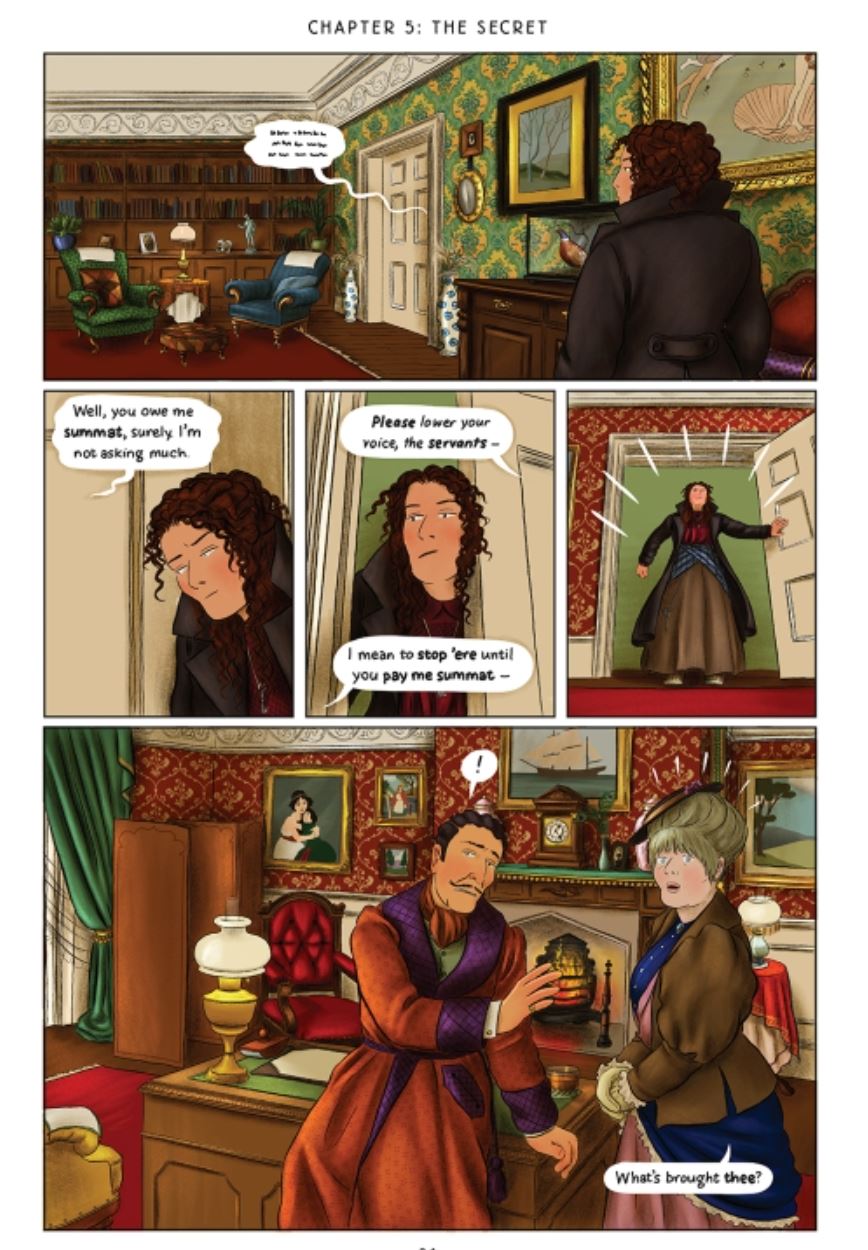
Adapted by Scarlett & Sophie Rickard, edited by David Hine (SelfMadeHero)
ISBN: 978-1-91422-435-5 (TPB)
This book includes Discriminatory Content included for dramatic effect.
Published in 1925, and set in the cotton town of Great Harwood, near Blackburn at the Edwardian height of the Lancashire weaving industry, the prose This Slavery explored the ironclad imbalances of the feudal class structure the industry depended upon and did it in terms of a then-fashionable romance novel. It was dismissed in many quarters because of it. Its author Ethel Carnie Holdsworth (January 1st 1886 – December 28th 1962) was a poet, journalist, editor, educator, children’s author and novelist (with at least 10 books released in her lifetime, and whose fashionable gothic romances briefly outsold works by H.G. Wells!) and the first working class woman in Britain to have a book published – Miss Nobody in 1913.
Working class and self-made, she escaped the drudgery of her birth to become a socialist intellectual, foe of fascism, successful author and ardent campaigner. However, she was gradually and in her own lifetime erased from history and public consciousness – perhaps because this daring experiment was intended to reach beyond the intelligentsia on both sides of the cultural battlegrounds. Maybe – just perhaps – it happened because this story recognised that even though all workers were equal, female ones were supposed to be less equal than all the rest, before then challenging that apparently sacrosanct sacred cow and credo…
Divided into two Books, this saga is sparked by the aftermath of a fire at Barstock’s mill. This triggers another cycle of unemployment, privation and deaths for the weakest. Workers are paid a pittance and toil at the owners’ discretion with no salaried protections. Even skilled workers lives depend on the pennies weaving factories dole out whenever the owners need them to, and unemployment is common and frequent. Now, with their only livelihood destroyed with no sign of reopening, many men are leaving for more favourable climes. Of course, their wives and sweethearts must remain…
Hester and Rachel Martin live with their mother and grandmother, one a fierce and ferocious firebrand advocate of political and social change for all and the other a fair-faced, gifted musician in search of peace and security. Life for them is scrounging and performing for pennies or else perpetually borrowing to make do. When their granny dies, they don’t even have the money to bury her…
As their friends and lovers leave, existence becomes ever more onerous, and each achieves a shocking revelation regarding a woman’s place in the grand schemes, Thus each chooses a difficult way to survive…
The manner in which each “gets by” is moodily realised in grittily oppressive episodes beginning with ‘Chapter One: The Proposal’ and inexorably unfolding in a tapestry of tragedy comprising ‘The Denial’, ‘The Exile’, ‘The Struggle’, ‘The Secret’, ‘The Inevitable’, ‘The Undesirables’, ‘The Last Snap’ and ‘The Commitment’ all confirming that the war for freedom and equality is a three way battle: rich vs poor vs women…
As Hester and Rachel each make life-changing decisions, the illustration embraces and resonates with powerful natural forces of nature and darkness opposed to crushing streets, oppressive architecture and shining gleaming inescapable artificial light that emotionally ground down the workers – employed or otherwise. Moreover, as Book Two sees the situation escalate into inevitable mass violence, readers are not allowed to forget that police, “scab” workers, and the military always have paid work to do…
As the drama leads to an inevitable conclusion each sister rediscovers her true nature via ‘Chapter Ten: The Negotiations’, ‘The Strike’, ‘The Lost Opportunity’, ‘The Innocents’, ‘The Beasts of the Jungle’, ‘The Revelations’, ‘The Rebellion’, ‘The Decision’ and momentous moment ‘The Last Battle’…
Like any inspirational tale espousing change, there is the hint of happy endings and brighter futures for all depicted in an ‘Epilogue’ with the entire story reinforced by a candid and thoughtful Afterword from adaptors Sophie & Scarlett Rickard (Mann’s Best Friend, A Blow Borne Quietly, The Ragged Trousered Philanthropists, No Surrender).
Righteously strident, passionately polemical and powerfully enraging, engaging, this never-more-timely tale of the eternal injustice and biologically apologist is superbly readable, dramatically enticing and should be compulsory viewing for all – as long as we don’t force anyone …
© 2025 SelfMadeHero. Text © 2025 Sophie Rickard. Artwork © 2025 Scarlett Rickard. All rights reserved.
Ethel Carnie Holdsworth’s This Slavery will be published on September 11th 2025 and is available for pre-order now.
Today in 1917, cartoonist/writer Frank Robbins was born. Among his many, many masterworks this character stands at the forefront.
